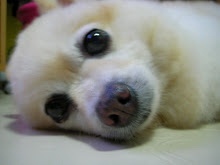Once again, we gathered at Marine South pier in the wee hours for a hunting-seeking survey at Semakau on the 22 Aug. We were quite short of volunteers that day, and some of us had to complete the survey on our own. On days like this, I really wish I have 8 arms like the Octopus. Its no mean feat to manage the ID chart, data recording sheet, chopsticks, camera and bottles, all at the same time. Halfway through the survey, I was really on the verge of pulling out my hair.
On the way to my survey column, which was pretty near the southern point (although far, I really like this area actually), a sandfish sea cucumber (Holothuria scabra) stood in my tracks. This is the sea cucumber that is served on our tables, although it needs to be processed before it is edible.
I stood by the rocks for a long time, trying to decide whether this false limpet is Siphonaria javanica or Siphonaria guamensis. Because of the thinner ribs, I guess its the Siphonaria guamensis. A false limpet, it breathes through lungs instead of gills. It is a mollusc which is cone shaped, flattened and has a very mascular foot that allow the animal to clamp the shells tightly against the substrate.
The entrance to the Turban shell (Turbo intercostalis) was completely sealed by its smooth trap door, also known as the operculum. This dome-shaped door protects the occupant from unwanted guests, and has pretty coloration, looking just like a cat's eye! This is also why the operculum is also called a cat's eye.
Among the seagrass meadow, many Fan Shells (Family Pinnidae) were spotted. The Fan Shell has a thin but strong shell and most of the shell is buried, pointed-end down. The razor sharp edge sticks out above the ground, so never walk barefooted across such meadows else risk getting cut by the unnoticed Fan Shell. This bivalve is a filter feeder and opens their shell a little at high tide.
I was eagerly looking out for money in the seagrass lagoon as as we were pre-empted that many can be found in our area. Not surprisingly, my not-so-keen eyes only saw 1 Sand dollar (Arachnoides placenta) which looks quite dead as it is smooth without any spines. This flat animal which got its name from its resemblance to the dollar coin, is related to the sea stars and other enchinoderms. They are deposit feeders and have tiny soft spines that it uses to burrow or move around. Similar to the sea stars, it is symmetrical along 5 axis and has a hydraulic water vascular system. It can even regenerate itself if a small part of it breaks.
There were lots of sand-sifting seastars (Archaster typicus), including one with 4 arms, and another with 6. Seems like its the mating season, as many of them were in pairs, in the pseudocopulation position. Although there is close physical contact between the 2 seastars, their eggs are actually externally fertilized. When the tide rises, the male on top with arms alternating that of the female, releases the sperms while the female releases the eggs.
This swimming crab had every reason to be aggressive to me. He probably thought it was very rude of me to intrude in his privacy while he was enjoying a hearty meal.
The Ovum Cowrie (Cypraea ovum) has an elegant, glossy and smooth shell, often with beautiful patterns. Before SK2 masks were invented, Cowries long knew the method of using its mantle to cover the shell's entire surface, thus keeping the surface smooth and glossy - exactly what ladies want for their face. In the olden days, cowries were used as currencies and more recently, over-collected for its beautiful shells. Sadly, I remember playing Congkak when I was small, at my Grandma's place, using cowrie shells! =(
A trip to Semakau is never complete without seeing the Knobbly Sea Star (Protoreaster nodosus). This sea star that I stumbled upon towards the end of the column startled me as I wasnt expecting to see it at all. The Knobbly is one of the largest sea star on our shores, and is now threatened by collection and habitat losses.
The Sentinel Crab (Macrophthalmus sp.) kept very still to pose for photo-taking. This inconsipicuous little crab, barely 3cm big, has a somewhat flattened, and rectangular body. It has eyes on long stalks which probably gave them their common name.
As usual, all of us left the intertidal area reluctantly, hoping for more time for the survey. Hopefully, we will have more volunteers on the next trip. =)











1 comment:
Money Cowrie Seashells (Cypraea moneta) are so named because they used to carry the value of money and were used just as we use money today. This particular seashell is found around coral reefs of the Indo-Pacific. Each shell is approximately 1/2".
____________________
Tools & Gifts For Your Spiritual Practice
Post a Comment